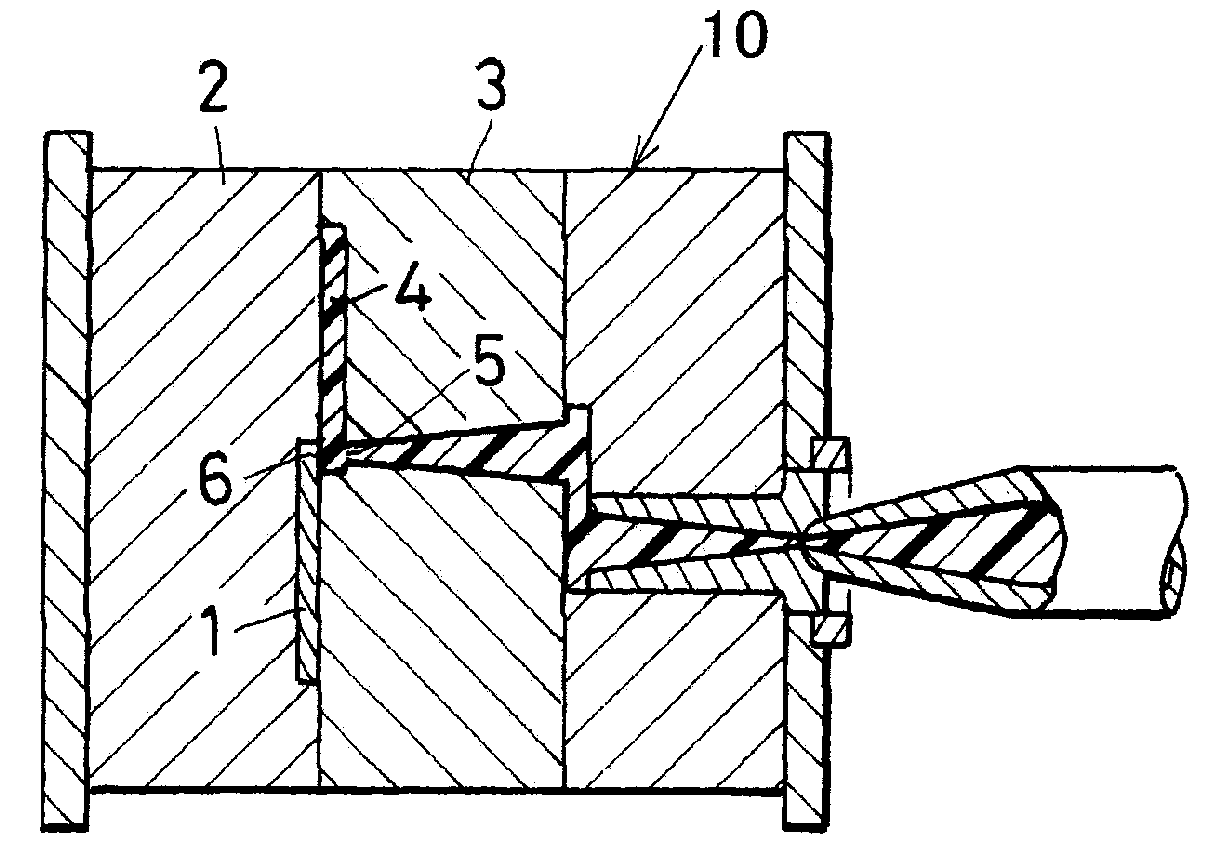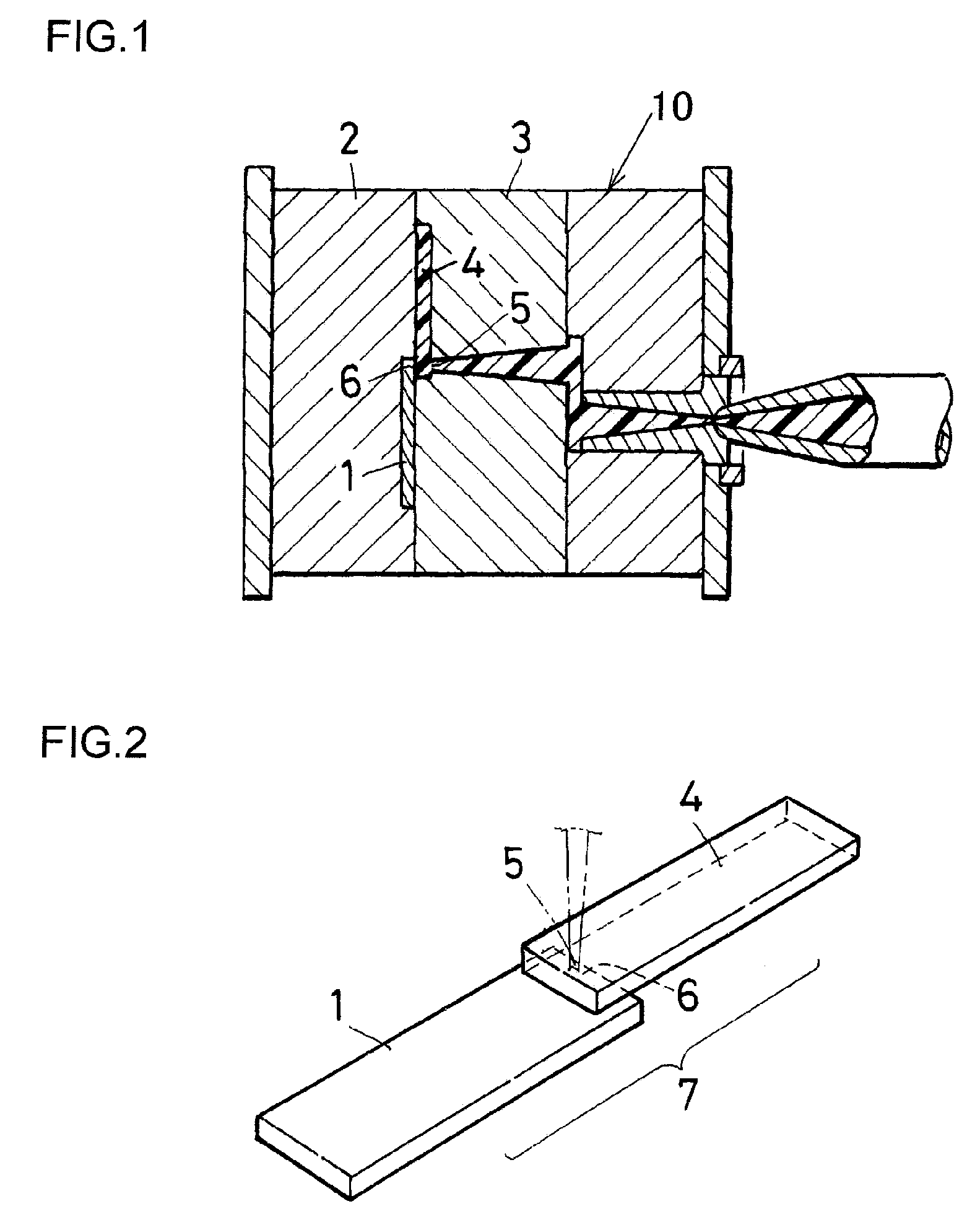Composite of metal and resin and method for manufacturing same
a technology of composites and metals, applied in the field of composites of metals and resins, can solve the problems of difficult to pull out the resin composition, the seed crystals cannot reach the farthest zones of the concave, etc., and achieve the effects of low resin strength of solidified resin, high production efficiency of composites, and low cos
- Summary
- Abstract
- Description
- Claims
- Application Information
AI Technical Summary
Benefits of technology
Problems solved by technology
Method used
Image
Examples
preparation example 1
of PPS Composition
[0079]The PPS Preparation Example 1 represents a preparation example in which PPS and a polyolefin resin were mixed. A total of 6,214 g of Na2S.2.9H2O and 17,000 g of N-methyl-2-pyrrolidone were charged into an autoclave having a capacity of 50 L and equipped with a stirrer, and the temperature was gradually raised to 205° C., while stirring under a nitrogen flow, to distill off 1355 g of water. The system was cooled to 140° C., then 7160 g of p-dichlorobenzene and 5000 g of N-methyl-2-pyrrolidone were added and the system was sealed under a nitrogen flow. The temperature of the system was raised to 225° C. within 2 h, and the system was polymerized for 2 h at 225° C. Then, the temperature was raised to 250° C. within 30 min and the polymerization was further continued for 3 h at 250° C.
[0080]Upon completion of polymerization, the polymer cooled to room temperature was isolated with a centrifugal separation machine. The solid fraction of the polymer was repeatedly ...
preparation example 2
of PPS Composition
[0082]The PPS composition (1) obtained in the Preparation Example 1 of a PPS composition was cured for 3 h at a temperature of 250° C. under an oxygen atmosphere to obtain PPS (referred to hereinbelow as PPS (3)). The melt viscosity of the PPS (3) thus obtained was 1800 poise. A total of 5.98 kg of the PPS (3) obtained and 0.02 kg of polyethylene “Nipolon Hard 8300A (product name)” (manufactured by Tosoh Corp., Tokyo, Japan) were premixed homogeneously in a tumbler. Then, the mixture was melt kneaded at a cylinder temperature of 300° C. in the twin-screw extruder “TEM-35B” (above-mentioned), while supplying glass fibers “RES03-TP91” having an average fiber diameter of 9 μm and a fiber length of 3 mm from a side feeder so as to obtain a total added amount of 40 wt. %, thereby producing a pelletized PPS composition (2). This composition is a resin composition in which the polyolefin resin takes 0.3% of the entire resin fraction. The PPS composition (2) thus obtained ...
preparation example 3
of PPS Composition
[0083]A total of 7.2 kg of the PPS composition (2) obtained in the Preparation Example 1 of a PPS composition and 0.8 kg of glycidyl methacrylate—ethylene copolymer “Bondfast E” (manufactured by Sumitomo Chemical Co., Ltd.) were premixed homogeneously in a tumbler. Then, the mixture was melt kneaded at a cylinder temperature of 300° C. in the twin-screw extruder “TEM-35B” (above-mentioned), while supplying glass fibers “RES03-TP91” having an average fiber diameter of 9 μm and a fiber length of 3 mm from a side feeder so as to obtain a total added amount of 20 wt. %, thereby producing a pelletized PPS composition (3). This composition is a resin composition in which the polyolefin resin takes 10% of the entire resin fraction. The PPS composition (3) thus obtained was dried for 5 h at 175C.
PUM
| Property | Measurement | Unit |
|---|---|---|
| Length | aaaaa | aaaaa |
| Percent by mass | aaaaa | aaaaa |
| Percent by mass | aaaaa | aaaaa |
Abstract
Description
Claims
Application Information
 Login to View More
Login to View More - R&D
- Intellectual Property
- Life Sciences
- Materials
- Tech Scout
- Unparalleled Data Quality
- Higher Quality Content
- 60% Fewer Hallucinations
Browse by: Latest US Patents, China's latest patents, Technical Efficacy Thesaurus, Application Domain, Technology Topic, Popular Technical Reports.
© 2025 PatSnap. All rights reserved.Legal|Privacy policy|Modern Slavery Act Transparency Statement|Sitemap|About US| Contact US: help@patsnap.com



